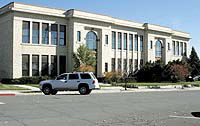| Price city officials voted last Wednesday to close the Price Community Center as soon as reasonably possible. The closure of the building will require various public and non-profit entities to find offices elsewhere. A report from the city engineer indicated that the facility is falling into disrepair. With renovation costs estimated near $1.6 million, the engineer recommended that the city consider demolishing it in the near future. |
Organizations currently occupying office space in the Price Community Center will be looking for new locations after a decision by the city council last Wednesday.
A recent evaluation of the building by Price City engineer Gary Sonntag showed that the building, which is known to many local residents as the old Central School, is deteriorating.
Sonntag noted that the building, located on the corner of 100 East 100 North, represented a significant improvement to the community at the time of the school’s construction.
However, as the 90-year-old building ages, it is suffering from significant problems that warrant the city closing and eventually demolishing the structure.
“There are cracks developing, bricks are coming loose and the paint is deteriorating,” said the engineer in his report to the council.
However, those problems are minor compared to others.
An engineering test performed by the city determined that the roof is sagging. That in turn is causing structural problems throughout the building.
In addition, the second floor of the building is entirely inaccessible to wheelchairs.
While the building had an elevator at one time, it was removed from the building. When it was removed, a plume of ground water developed in the absence of the weight of the elevator.
Sonntag explained that the plume may be causing other structural problems in the building. Further, lacking the elevator, the building does not comply with the Americans with Disabilities Act.
One of the more significant problems that city maintenance crews are having to tackle relates to the building’s sewer system which is requiring maintenance on a weekly basis.
Without a sewer, the building has no restrooms, and without restrooms, it shouldn’t be used, explained Sonntag.
Costs to operate the building exceed the revenue generated by its use. Sonntag said the city is spending $19,000 more for operation of the building than it is pulling in from revenue.
The costs to bring the building back into compliance would likely exceed $1.6 million, according to Sonntag.
“The building is really not in a condition there is could be remodeled successfully,” he said.
Sonntag summarized his recommendation to the council by explaining that the use of the building should be stopped, and that the city should make plans to demolish the structure.
“The building should be closed soon,” he said.
Occupants of the building should be asked to leave in as little as 30 days, recommended Sonntag. However, he recommended that the city make an effort to ease hardship on the current occupants and try to find space for as many as possible within the city’s system.
One possibility for some of occupants could be the offices currently used by the city’s police department. However, Police Chief Aleck Shilaos said that the department will not move to its new facility until December at the earliest, and likely not until January or later.
The council had at one time considered the possibility of transferring the tourism and economic development offices, which work closely with each other, to the space currently occupied by the police. In addition, the city’s fire department has indicated that it could use additional space within the building.
Considering that the city plans to remodel the space currently used by the police, the space will likely not be usable with within the time frame recommended Sonntag.
“We’re concerned about the occupants,” said Mayor Joe Piccolo. He encouraged the council to try to alleviate undue hardship on the current occupants as it made a decision regarding the building.
The council agreed to have occupants vacate the building as soon as practical and that the city make efforts to find space, even if on a temporary basis, within the city’s system of building.

